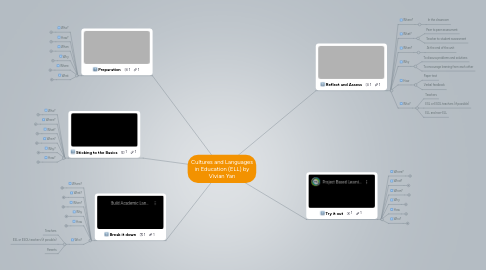
1. Preparation
1.1. Who?
1.1.1. Teachers
1.1.2. ESL or ESOL teachers (if possible)
1.2. How?
1.2.1. Pictures with both visual and text including simple instructions such as “Raise your hand.” “Listen.” “How do you spell….?” “May I….?” etc in the classroom
1.2.2. A "Weekly Challenge" section with a question updated every week.
1.2.3. Others: calendar with months and dates, world map showing different countries around the world with pictures of different cultural groups and customs with an arrow pointing to the country described to promote cultural diversity
1.2.4. Posters about subject matter, some examples are: numbers, phonics, body parts, periodic table, and good study habits with both visual and text
1.2.5. Rearrange seats for ELL to sit with student(s) who speak their native language to help translate for students with basic English proficiency to provide support and social inclusion.
1.3. When
1.3.1. Update on a weekly basis, if time allows, if not, bi-weekly, make sure information is up to date
1.4. Why
1.4.1. Create a multicultural learning environment that allows students to interact each other and with the teacher
1.5. Where
1.5.1. In the classroom
1.6. What
1.6.1. Teachers should research and create a fair learning environment for all students including ELL students to make them feel comfortable
1.6.2. Teachers should identify ELL from class list and create a classroom before class starts at the beginning of the semester.
2. Sticking to the Basics
2.1. Who?
2.1.1. Teachers
2.1.2. ELL
2.2. Where?
2.2.1. In the classroom
2.2.2. At home
2.3. What?
2.3.1. Teachers can help ELL build vocabulary and daily English conversations.
2.4. When?
2.4.1. New flash cards every week
2.5. Why?
2.5.1. To help ELL to gain confidence in speaking English and include them in the learning process, same as everyone else
2.6. How?
2.6.1. Using flashcards with a picture on one side and the word on the other, for higher level ELL it could be a word and a simple sentence on the other side to explain the meaning of the word
2.6.2. Use dictionary or electronic translator
2.6.3. Give a handout that contains summary and main vocabulary from class so students can review main concepts
2.6.4. Sticky note to match item and word
3. Break it down
3.1. Where?
3.1.1. In the classroom
3.1.2. Outside the classroom
3.2. What?
3.2.1. Explain concepts by showing steps, break down complicated concepts into smaller ones, use key words that are easy to understand
3.2.2. Encourage student participation through both verbal and written communication
3.2.3. Allow time for students to process, BICS and CALP acquisition
3.3. When?
3.3.1. Every class
3.4. Why
3.4.1. To include ELL and other students to participate in and out of the classroom
3.5. How
3.5.1. Use stories or narratives
3.5.2. Start a thread on forum, ask students to comment and post pictures that relate to the topic
3.5.3. Use Pinterest posts, infographic and Powerpoint presentation
3.6. Who?
3.6.1. Teachers
3.6.2. ESL or ESOL teachers (if possible)
3.6.3. Parents
4. Reflect and Assess
4.1. Where?
4.1.1. In the classroom
4.2. What?
4.2.1. Peer to peer assessment
4.2.2. Teacher to student assessment
4.3. When?
4.3.1. At the end of the unit
4.4. Why
4.4.1. To discuss problems and solutions
4.4.2. To encourage learning from each other
4.5. How
4.5.1. Paper test
4.5.2. Verbal feedback
4.6. Who?
4.6.1. Teachers
4.6.2. ESL or ESOL teachers (if possible)
4.6.3. ELL and non-ELL
5. Try it out
5.1. Where?
5.1.1. In the classroom
5.2. What?
5.2.1. Motivate students to learn by giving them tasks to complete
5.2.2. Activity-based learning, project-based learning and learn by doing involve hands-on experience
5.3. When?
5.3.1. Once a week or once every two weeks depending on complexity of assignment
5.4. Why
5.4.1. To include ELL and other students to participate in and out of the classroom
5.4.2. To prepare students for future careers
5.5. How
5.5.1. Retell the story
5.5.2. Role-play
5.5.3. Creative writing
5.5.4. Games
5.5.4.1. Trivia
5.5.4.2. Guess who
5.5.4.3. What's missing
5.6. Who?
5.6.1. Teachers
5.6.2. ELL teachers (if possible)
5.6.3. ELL and other students
